US History: Reconstruction, Industrialization & American Imperialism
VerifiedAdded on 2023/05/30
|7
|1507
|469
Essay
AI Summary
This essay provides an overview of the Reconstruction Era in the United States, highlighting the legal and social changes that occurred, including the 13th, 14th, and 15th Amendments and the emergence of Jim Crow laws. It discusses the impact of these changes on freedmen, the rise of violent groups, and the economic conditions of the time, such as sharecropping. The essay also examines the influence of industrialization, contrasting the industrial North with the agrarian South and its reliance on slave labor. Furthermore, it explores the Progressive Movement, including labor reforms, the Social Gospel, and women's suffrage, as well as key amendments like the 16th, 17th, 18th, and 19th. Finally, it delves into American imperialism, focusing on the annexation of Hawaii and the Spanish-American War, illustrating the country's expansionist ambitions and the consequences of these actions.
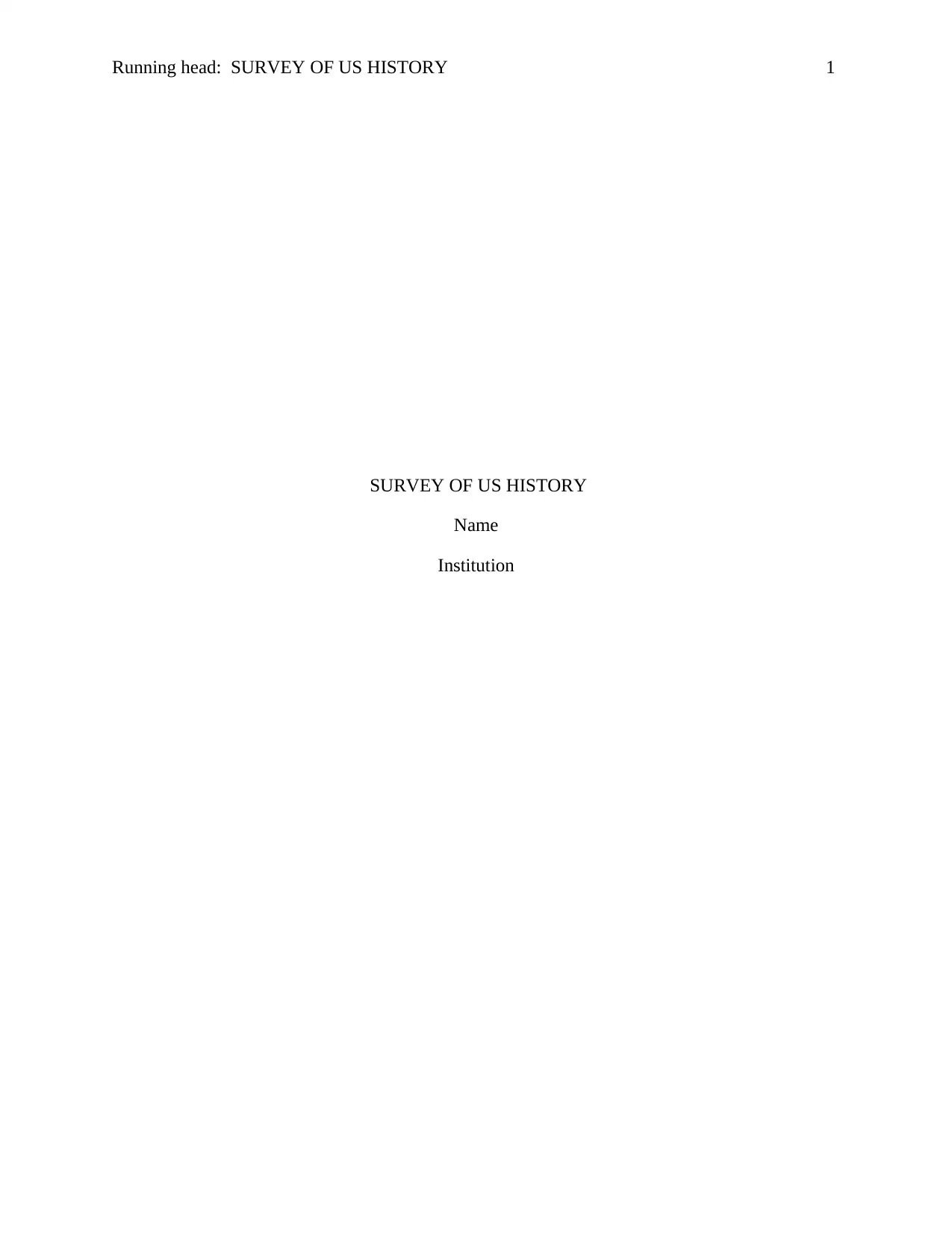
Running head: SURVEY OF US HISTORY 1
SURVEY OF US HISTORY
Name
Institution
SURVEY OF US HISTORY
Name
Institution
Paraphrase This Document
Need a fresh take? Get an instant paraphrase of this document with our AI Paraphraser

SURVEY OF US HISTORY 2
SURVEY OF US HISTORY
There are many changes which took place due to the Reconstructive era. Laws were
written, amendments were enacted, and many people responded in different ways. Politicians, as
well as City officials and Law enforcement, established creative methods to break these new
amendments and laws (Rosen, 2017). Fraud, disenfranchisement, and bribery were some of the
ways the people reacted to them. Violent groups such as Kiu Klux Klan, white league, and Red
Shirt, took swift and frequently prohibited actions while employing lethal and even harmful
forces. To the supporter of the Salem witch trial, the only thing needed to change the attention
off of individuals was the air of suspicion. Some freedmen began migrating to the west in the
hope of getting a better life; they were in search of a life without crime or violence.
13th amendment: At an unstable moment in the history of the country, the government
of the day took charge against any of the social problems. On 31/1/1885, the government of the
United States enacted a ground breaking amendment that was capable of changing the life of
United State citizens. This amendment abolished involuntary servitude, and slavery, except when
they are used as a form of punishment for crime.
14th amendment: This amendment was passed on 13/6/1886. This amendment describes
citizenship as well as the right of citizens by use of the immunities and privileges clause, Equal
protection clause, and Due process clause.
15th amendment: The government of the United States passed the 15th amendment on
26/2/1869. When prejudice, corrupt officials were finding ways of denying freedmen their rights
and privileges, Congress enacts a different groundbreaking amendment.
SURVEY OF US HISTORY
There are many changes which took place due to the Reconstructive era. Laws were
written, amendments were enacted, and many people responded in different ways. Politicians, as
well as City officials and Law enforcement, established creative methods to break these new
amendments and laws (Rosen, 2017). Fraud, disenfranchisement, and bribery were some of the
ways the people reacted to them. Violent groups such as Kiu Klux Klan, white league, and Red
Shirt, took swift and frequently prohibited actions while employing lethal and even harmful
forces. To the supporter of the Salem witch trial, the only thing needed to change the attention
off of individuals was the air of suspicion. Some freedmen began migrating to the west in the
hope of getting a better life; they were in search of a life without crime or violence.
13th amendment: At an unstable moment in the history of the country, the government
of the day took charge against any of the social problems. On 31/1/1885, the government of the
United States enacted a ground breaking amendment that was capable of changing the life of
United State citizens. This amendment abolished involuntary servitude, and slavery, except when
they are used as a form of punishment for crime.
14th amendment: This amendment was passed on 13/6/1886. This amendment describes
citizenship as well as the right of citizens by use of the immunities and privileges clause, Equal
protection clause, and Due process clause.
15th amendment: The government of the United States passed the 15th amendment on
26/2/1869. When prejudice, corrupt officials were finding ways of denying freedmen their rights
and privileges, Congress enacts a different groundbreaking amendment.
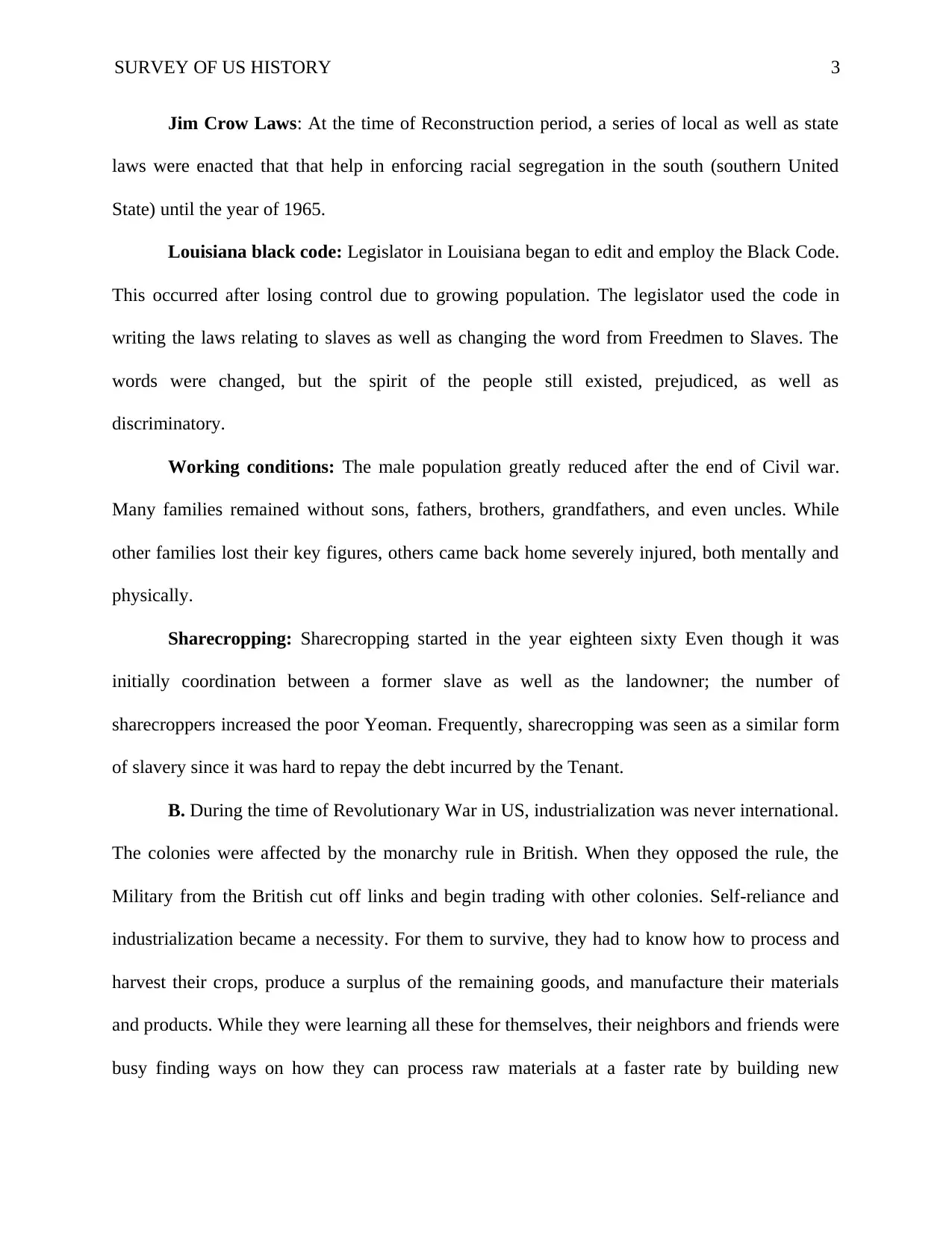
SURVEY OF US HISTORY 3
Jim Crow Laws: At the time of Reconstruction period, a series of local as well as state
laws were enacted that that help in enforcing racial segregation in the south (southern United
State) until the year of 1965.
Louisiana black code: Legislator in Louisiana began to edit and employ the Black Code.
This occurred after losing control due to growing population. The legislator used the code in
writing the laws relating to slaves as well as changing the word from Freedmen to Slaves. The
words were changed, but the spirit of the people still existed, prejudiced, as well as
discriminatory.
Working conditions: The male population greatly reduced after the end of Civil war.
Many families remained without sons, fathers, brothers, grandfathers, and even uncles. While
other families lost their key figures, others came back home severely injured, both mentally and
physically.
Sharecropping: Sharecropping started in the year eighteen sixty Even though it was
initially coordination between a former slave as well as the landowner; the number of
sharecroppers increased the poor Yeoman. Frequently, sharecropping was seen as a similar form
of slavery since it was hard to repay the debt incurred by the Tenant.
B. During the time of Revolutionary War in US, industrialization was never international.
The colonies were affected by the monarchy rule in British. When they opposed the rule, the
Military from the British cut off links and begin trading with other colonies. Self-reliance and
industrialization became a necessity. For them to survive, they had to know how to process and
harvest their crops, produce a surplus of the remaining goods, and manufacture their materials
and products. While they were learning all these for themselves, their neighbors and friends were
busy finding ways on how they can process raw materials at a faster rate by building new
Jim Crow Laws: At the time of Reconstruction period, a series of local as well as state
laws were enacted that that help in enforcing racial segregation in the south (southern United
State) until the year of 1965.
Louisiana black code: Legislator in Louisiana began to edit and employ the Black Code.
This occurred after losing control due to growing population. The legislator used the code in
writing the laws relating to slaves as well as changing the word from Freedmen to Slaves. The
words were changed, but the spirit of the people still existed, prejudiced, as well as
discriminatory.
Working conditions: The male population greatly reduced after the end of Civil war.
Many families remained without sons, fathers, brothers, grandfathers, and even uncles. While
other families lost their key figures, others came back home severely injured, both mentally and
physically.
Sharecropping: Sharecropping started in the year eighteen sixty Even though it was
initially coordination between a former slave as well as the landowner; the number of
sharecroppers increased the poor Yeoman. Frequently, sharecropping was seen as a similar form
of slavery since it was hard to repay the debt incurred by the Tenant.
B. During the time of Revolutionary War in US, industrialization was never international.
The colonies were affected by the monarchy rule in British. When they opposed the rule, the
Military from the British cut off links and begin trading with other colonies. Self-reliance and
industrialization became a necessity. For them to survive, they had to know how to process and
harvest their crops, produce a surplus of the remaining goods, and manufacture their materials
and products. While they were learning all these for themselves, their neighbors and friends were
busy finding ways on how they can process raw materials at a faster rate by building new
⊘ This is a preview!⊘
Do you want full access?
Subscribe today to unlock all pages.

Trusted by 1+ million students worldwide
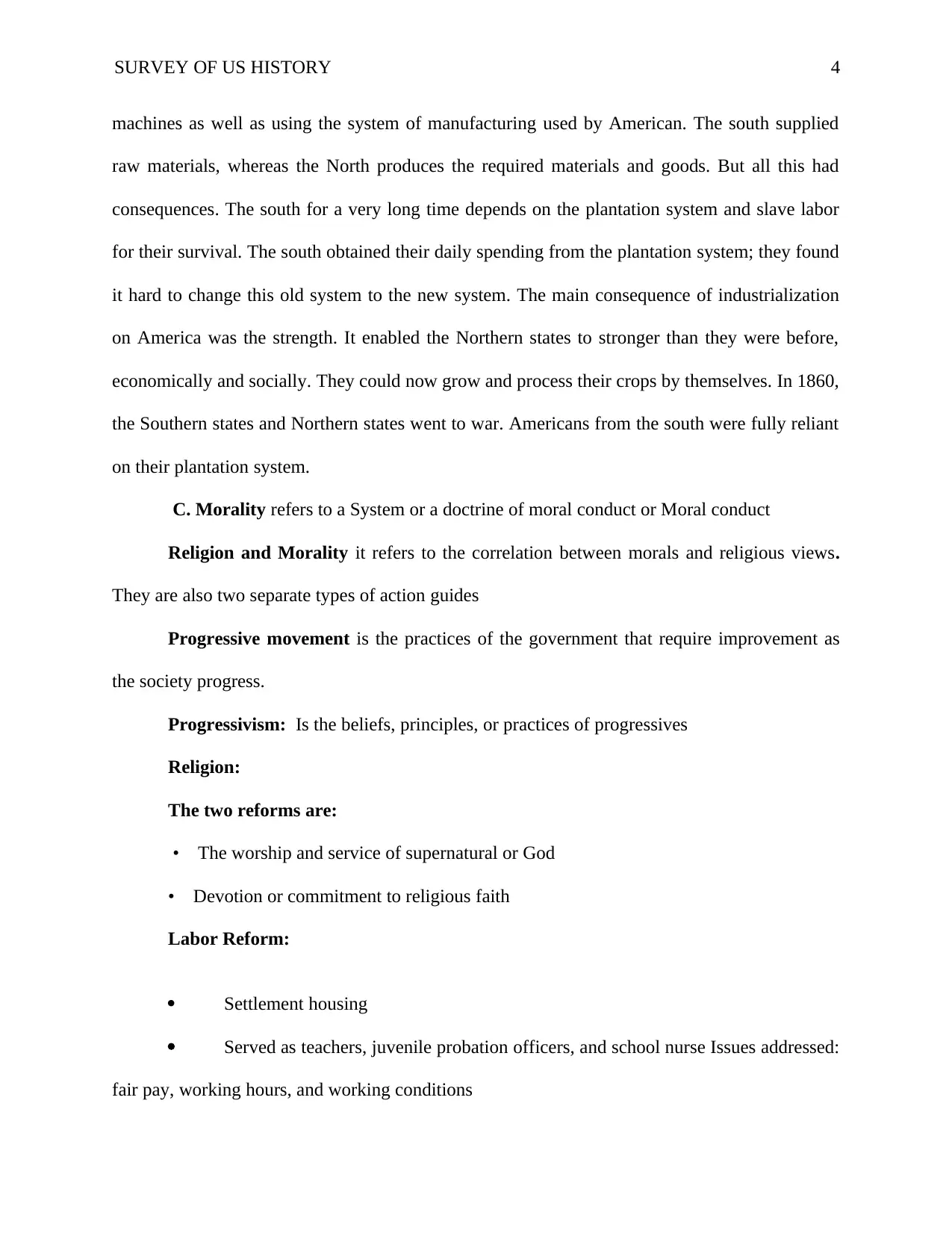
SURVEY OF US HISTORY 4
machines as well as using the system of manufacturing used by American. The south supplied
raw materials, whereas the North produces the required materials and goods. But all this had
consequences. The south for a very long time depends on the plantation system and slave labor
for their survival. The south obtained their daily spending from the plantation system; they found
it hard to change this old system to the new system. The main consequence of industrialization
on America was the strength. It enabled the Northern states to stronger than they were before,
economically and socially. They could now grow and process their crops by themselves. In 1860,
the Southern states and Northern states went to war. Americans from the south were fully reliant
on their plantation system.
C. Morality refers to a System or a doctrine of moral conduct or Moral conduct
Religion and Morality it refers to the correlation between morals and religious views.
They are also two separate types of action guides
Progressive movement is the practices of the government that require improvement as
the society progress.
Progressivism: Is the beliefs, principles, or practices of progressives
Religion:
The two reforms are:
• The worship and service of supernatural or God
• Devotion or commitment to religious faith
Labor Reform:
Settlement housing
Served as teachers, juvenile probation officers, and school nurse Issues addressed:
fair pay, working hours, and working conditions
machines as well as using the system of manufacturing used by American. The south supplied
raw materials, whereas the North produces the required materials and goods. But all this had
consequences. The south for a very long time depends on the plantation system and slave labor
for their survival. The south obtained their daily spending from the plantation system; they found
it hard to change this old system to the new system. The main consequence of industrialization
on America was the strength. It enabled the Northern states to stronger than they were before,
economically and socially. They could now grow and process their crops by themselves. In 1860,
the Southern states and Northern states went to war. Americans from the south were fully reliant
on their plantation system.
C. Morality refers to a System or a doctrine of moral conduct or Moral conduct
Religion and Morality it refers to the correlation between morals and religious views.
They are also two separate types of action guides
Progressive movement is the practices of the government that require improvement as
the society progress.
Progressivism: Is the beliefs, principles, or practices of progressives
Religion:
The two reforms are:
• The worship and service of supernatural or God
• Devotion or commitment to religious faith
Labor Reform:
Settlement housing
Served as teachers, juvenile probation officers, and school nurse Issues addressed:
fair pay, working hours, and working conditions
Paraphrase This Document
Need a fresh take? Get an instant paraphrase of this document with our AI Paraphraser
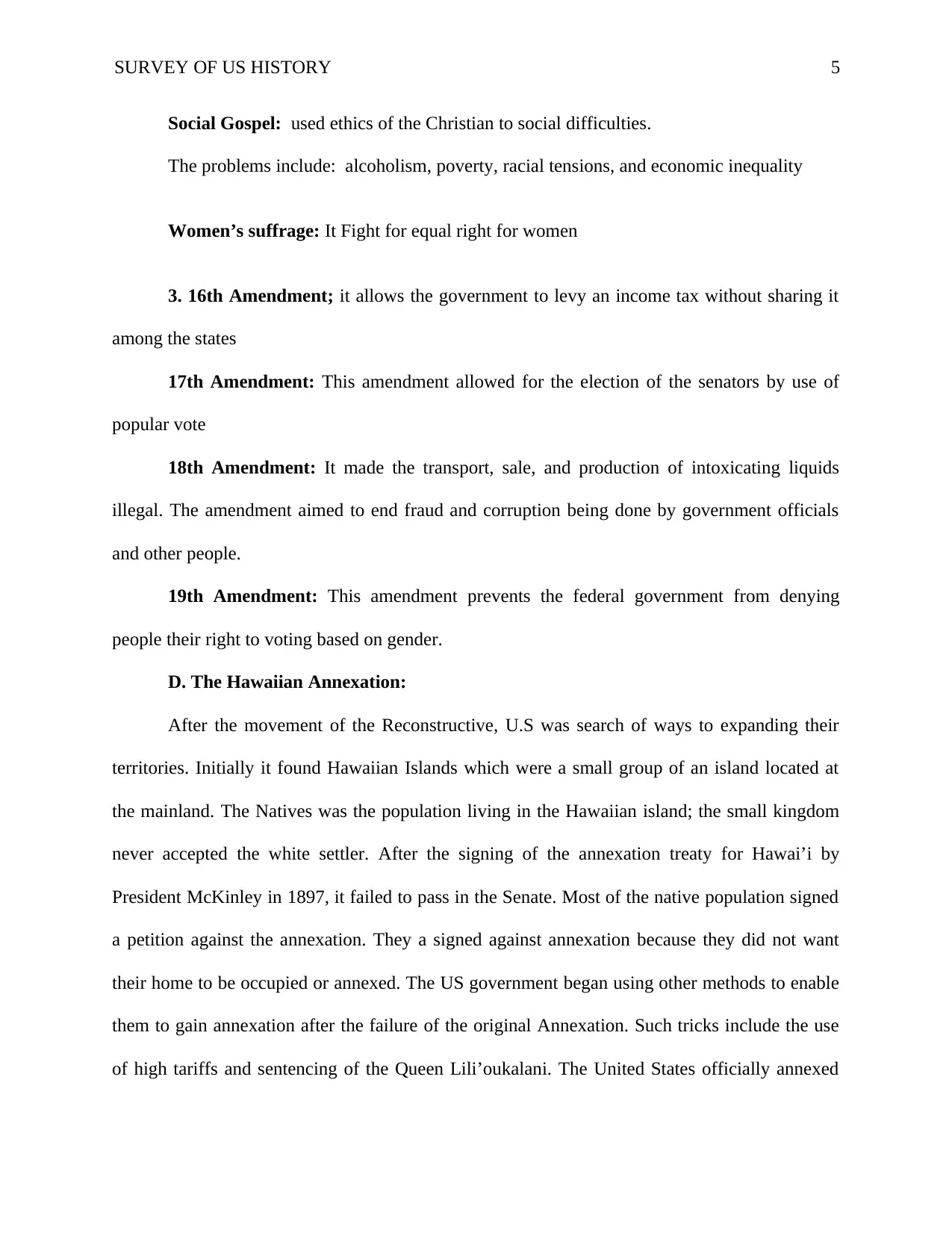
SURVEY OF US HISTORY 5
Social Gospel: used ethics of the Christian to social difficulties.
The problems include: alcoholism, poverty, racial tensions, and economic inequality
Women’s suffrage: It Fight for equal right for women
3. 16th Amendment; it allows the government to levy an income tax without sharing it
among the states
17th Amendment: This amendment allowed for the election of the senators by use of
popular vote
18th Amendment: It made the transport, sale, and production of intoxicating liquids
illegal. The amendment aimed to end fraud and corruption being done by government officials
and other people.
19th Amendment: This amendment prevents the federal government from denying
people their right to voting based on gender.
D. The Hawaiian Annexation:
After the movement of the Reconstructive, U.S was search of ways to expanding their
territories. Initially it found Hawaiian Islands which were a small group of an island located at
the mainland. The Natives was the population living in the Hawaiian island; the small kingdom
never accepted the white settler. After the signing of the annexation treaty for Hawai’i by
President McKinley in 1897, it failed to pass in the Senate. Most of the native population signed
a petition against the annexation. They a signed against annexation because they did not want
their home to be occupied or annexed. The US government began using other methods to enable
them to gain annexation after the failure of the original Annexation. Such tricks include the use
of high tariffs and sentencing of the Queen Lili’oukalani. The United States officially annexed
Social Gospel: used ethics of the Christian to social difficulties.
The problems include: alcoholism, poverty, racial tensions, and economic inequality
Women’s suffrage: It Fight for equal right for women
3. 16th Amendment; it allows the government to levy an income tax without sharing it
among the states
17th Amendment: This amendment allowed for the election of the senators by use of
popular vote
18th Amendment: It made the transport, sale, and production of intoxicating liquids
illegal. The amendment aimed to end fraud and corruption being done by government officials
and other people.
19th Amendment: This amendment prevents the federal government from denying
people their right to voting based on gender.
D. The Hawaiian Annexation:
After the movement of the Reconstructive, U.S was search of ways to expanding their
territories. Initially it found Hawaiian Islands which were a small group of an island located at
the mainland. The Natives was the population living in the Hawaiian island; the small kingdom
never accepted the white settler. After the signing of the annexation treaty for Hawai’i by
President McKinley in 1897, it failed to pass in the Senate. Most of the native population signed
a petition against the annexation. They a signed against annexation because they did not want
their home to be occupied or annexed. The US government began using other methods to enable
them to gain annexation after the failure of the original Annexation. Such tricks include the use
of high tariffs and sentencing of the Queen Lili’oukalani. The United States officially annexed
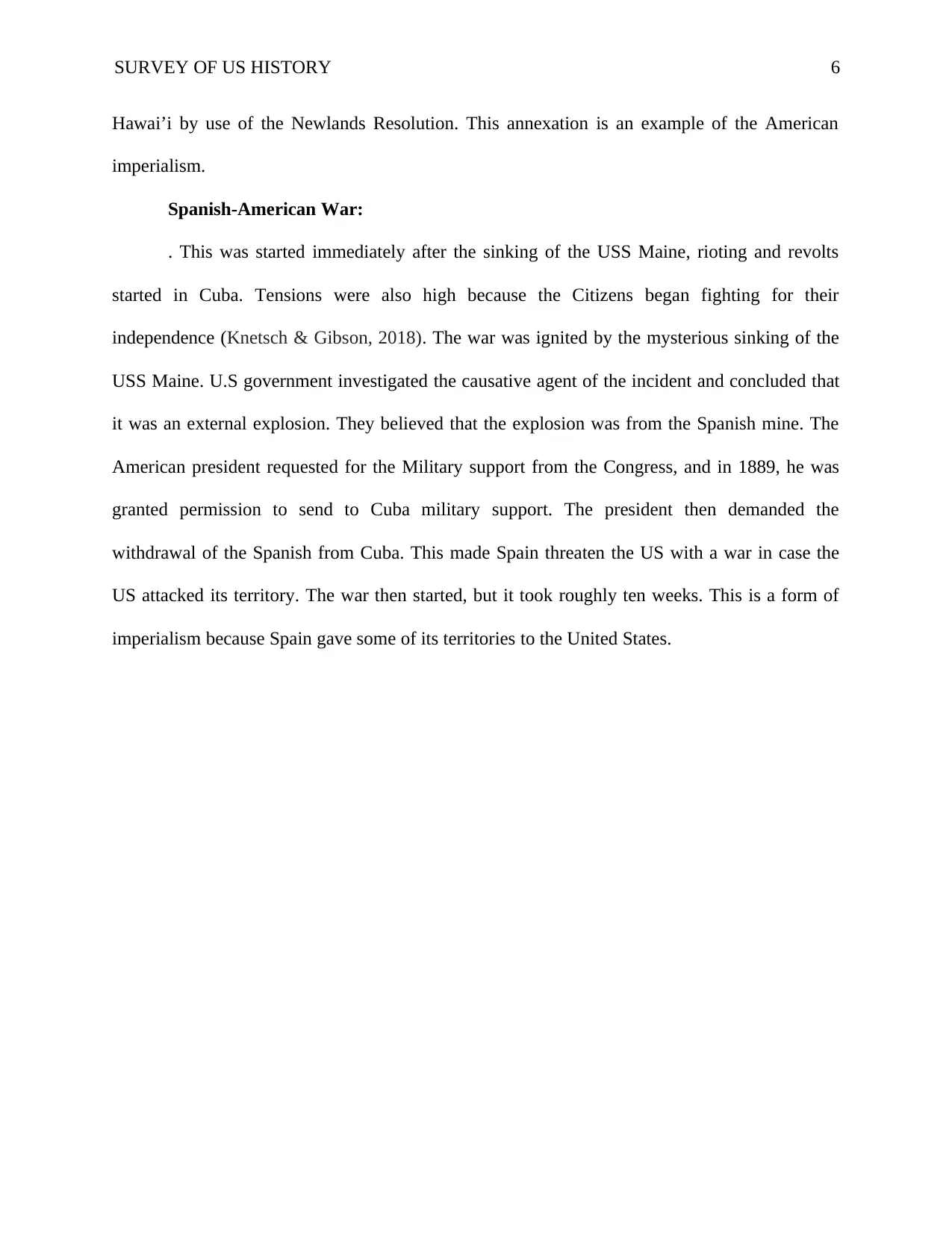
SURVEY OF US HISTORY 6
Hawai’i by use of the Newlands Resolution. This annexation is an example of the American
imperialism.
Spanish-American War:
. This was started immediately after the sinking of the USS Maine, rioting and revolts
started in Cuba. Tensions were also high because the Citizens began fighting for their
independence (Knetsch & Gibson, 2018). The war was ignited by the mysterious sinking of the
USS Maine. U.S government investigated the causative agent of the incident and concluded that
it was an external explosion. They believed that the explosion was from the Spanish mine. The
American president requested for the Military support from the Congress, and in 1889, he was
granted permission to send to Cuba military support. The president then demanded the
withdrawal of the Spanish from Cuba. This made Spain threaten the US with a war in case the
US attacked its territory. The war then started, but it took roughly ten weeks. This is a form of
imperialism because Spain gave some of its territories to the United States.
Hawai’i by use of the Newlands Resolution. This annexation is an example of the American
imperialism.
Spanish-American War:
. This was started immediately after the sinking of the USS Maine, rioting and revolts
started in Cuba. Tensions were also high because the Citizens began fighting for their
independence (Knetsch & Gibson, 2018). The war was ignited by the mysterious sinking of the
USS Maine. U.S government investigated the causative agent of the incident and concluded that
it was an external explosion. They believed that the explosion was from the Spanish mine. The
American president requested for the Military support from the Congress, and in 1889, he was
granted permission to send to Cuba military support. The president then demanded the
withdrawal of the Spanish from Cuba. This made Spain threaten the US with a war in case the
US attacked its territory. The war then started, but it took roughly ten weeks. This is a form of
imperialism because Spain gave some of its territories to the United States.
⊘ This is a preview!⊘
Do you want full access?
Subscribe today to unlock all pages.

Trusted by 1+ million students worldwide
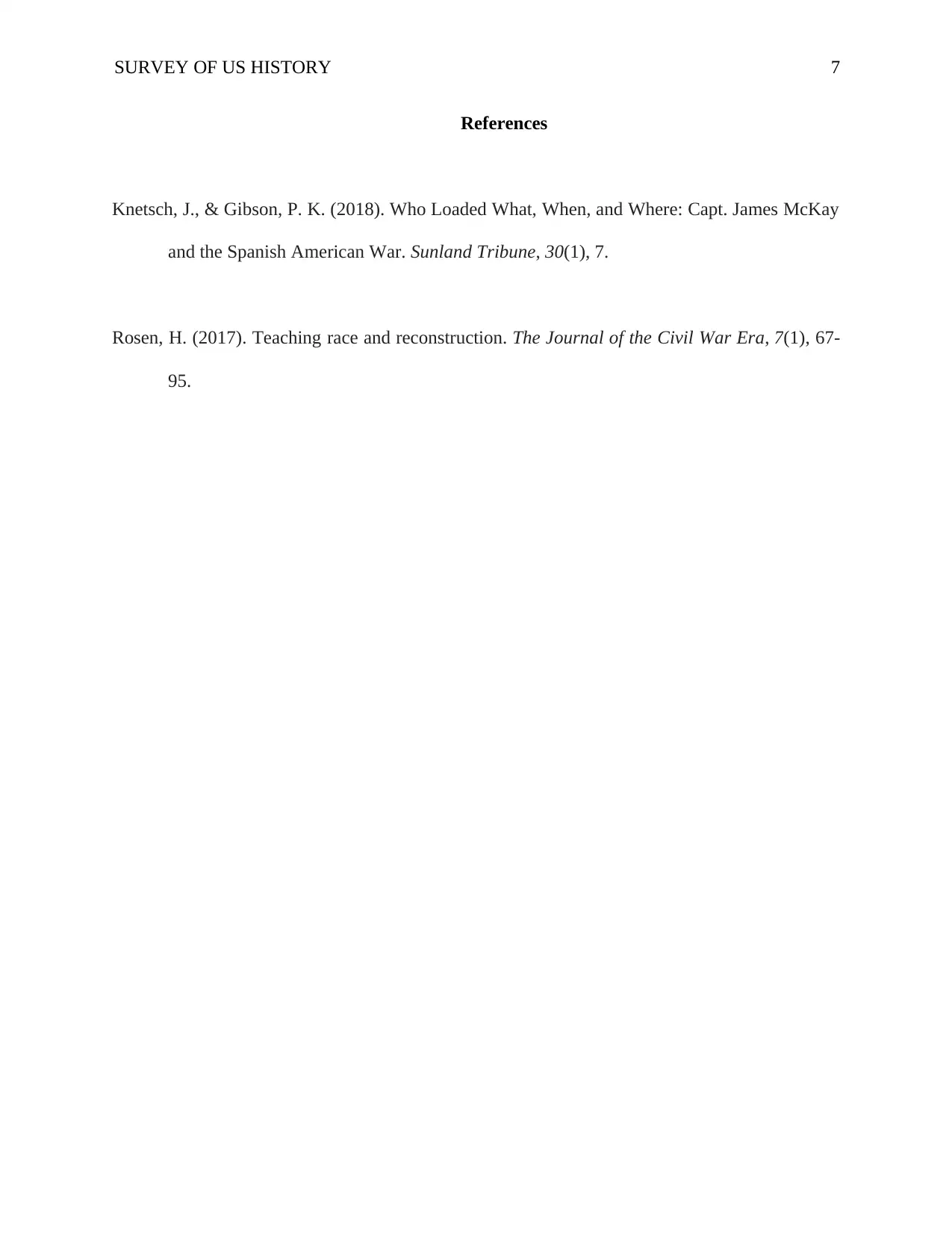
SURVEY OF US HISTORY 7
References
Knetsch, J., & Gibson, P. K. (2018). Who Loaded What, When, and Where: Capt. James McKay
and the Spanish American War. Sunland Tribune, 30(1), 7.
Rosen, H. (2017). Teaching race and reconstruction. The Journal of the Civil War Era, 7(1), 67-
95.
References
Knetsch, J., & Gibson, P. K. (2018). Who Loaded What, When, and Where: Capt. James McKay
and the Spanish American War. Sunland Tribune, 30(1), 7.
Rosen, H. (2017). Teaching race and reconstruction. The Journal of the Civil War Era, 7(1), 67-
95.
1 out of 7
Related Documents
Your All-in-One AI-Powered Toolkit for Academic Success.
+13062052269
info@desklib.com
Available 24*7 on WhatsApp / Email
![[object Object]](/_next/static/media/star-bottom.7253800d.svg)
Unlock your academic potential
Copyright © 2020–2025 A2Z Services. All Rights Reserved. Developed and managed by ZUCOL.




